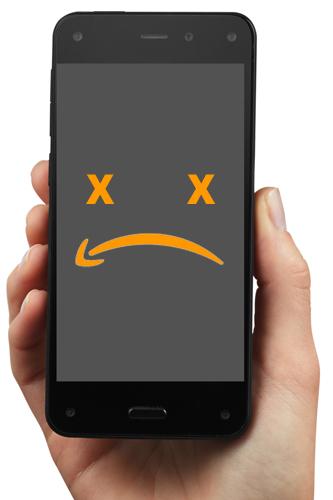January 9, 2015

There was a time, less than six months ago, when an Amazon Fire Phone would have cost you $199 with a two-year contract ($650 without). Today, you can snag one for a whopping $0.99 and Amazon has reportedly taken a $170 million hit on the device. So what happened?
A new piece in Fast Company reveals the inside story of the Fire Phone. And it's a fascinating tale of what can go wrong when a tech company branches out into new product offerings. It's a story of how Amazon CEO Jeff Bezos rolled the dice in a big way, and came up snake eyes. With Amazon's Kindle the standard in e-readers and the success of Fire TV and Amazon Prime there's no reason Bezos shouldn't have thought his company could create the next hot smartphone. Amazon is a company that uses automated robots in its shipping facilities for goodness sake. Why shouldn't a company like that think it could take on Apple and Samsung on the hardware front?
The hardware's performance wasn't the problem. A teardown revealed a device more than capable of competing with any Android and iOS phone out there. It even had some novel features, most notably the Dynamic Perspective feature that used four cameras mounted into the phone, coupled with a gyroscope, to give users the ability to navigate shortcuts and menus by changing the orientation of the phone. Want to scroll a website? Just tilt the phone the right way.
What really went wrong is a fascinating conglomeration of failed ambition, over-engineering, and outright hubris.
Writer Austin Carr quotes one member of the Fire design team who believes that Bezos' hampered the project with excessive micromanaging. Quoting his source, Carr writes:
“And I thought, 'This is a CEO who cares about design; what a wonderful place to be.' Eventually, however, this designer grew frustrated, as did others. "In essence, we were not building the phone for the customer -- we were building it for Jeff," this source says. With Bezos managing every critical decision, teams began second-guessing themselves trying to anticipate how he would react.
Other problems arose in the process as well -- with particular challenges coming up with the Dynamic Perspective technology -- the phone's buzziest aspect as well as its most problematic. The Fire team was tasked with creating a 3D display that required no glasses, and could be viewed from multiple angles. Engineers found a solution in this, using four cameras and facial recognition, but things just went off the rails from there. Anyone with one camera on their phone can tell you about battery drain. Imagine the effect on battery life of four cameras, capable of doing facial recognition even in the dark or with the user's face hidden behind sunglasses. It's exactly what Amazon's designers ran into.
Bezos comes off as an aspiring Steve Jobs figure, unflinching and driving his team to implement the killer app come hell or high water:
“After a first set of leaders assigned to the project failed to deliver, their replacements went on a hiring spree. One team even set up a room that they essentially turned into a costume store, filling it with wigs, sunglasses, fake moustaches, and earrings that they donned for the cameras in order to improve facial recognition... "I want this feature," Bezos said, telling the team he didn’t care how long it took or how much it cost.
Despite some unique features, the Fire Phone debuted to mixed reviews at best. The overall consensus is that the thing just wasn't “cool” enough. Critics describe Amazon as a company that is inherently not cool trying (and failing) to use its new smartphone to earn a spot at the cool kids' table.
There were also some aspects of the phone that were just outright silly. Take the Firefly feature for instance. It was a tool that used text, sound, and photo recognition to identify objects that the phone would then link you to buy in the Amazon.com store (because...Amazon). It's hard to imagine a consumer walking around their house scanning groceries and products with their phone just so they can order them online. Think about someone walking around an actual store or mall doing this and the idea becomes even more preposterous -- save for anyone who sits at the horrifying cross section of being both a tech junky and the sort of person stores hire extra security for on Black Friday.
Big products and hot ideas come and go all the time. Just ask the plethora of companies who exhibit at CES every year only to vanish into the ether soon after. In a time where big companies feel the need to attack multiple markets and take on brand new ventures from phones, to TV, all the way to healthcare, stories like the Fire Phone make a good argument for specialization. Google got to create automated cars by first being the undisputed heavyweight champ of online search. And Apple and Samsung may branch out, but they do so while continuously playing on their strengths as hardware companies first and foremost.
You can respect the ambition, but maybe Amazon should stick with what it does best just a bit longer.
What do you think went wrong with the Fire Phone? Did anyone try one out for yourself? Let us know in the comments section below.
Design engineers and professionals, the West Coast’s most important design, innovation, and manufacturing event, Pacific Design & Manufacturing, is taking place in Anaheim, Feb. 10-12, 2015. A Design News event, Pacific Design & Manufacturing is your chance to meet qualified suppliers, get hands-on access to the latest technologies, be informed from a world-class conference program, and expand your network. (You might even meet a Design News editor.) Learn more about Pacific Design & Manufacturing here.
About the Author(s)
You May Also Like



